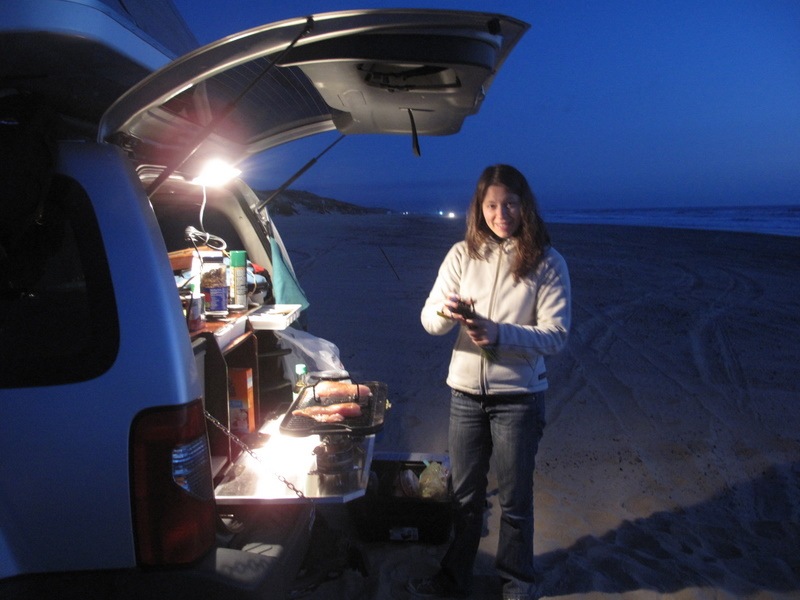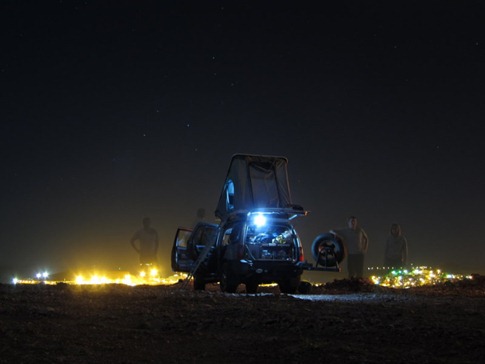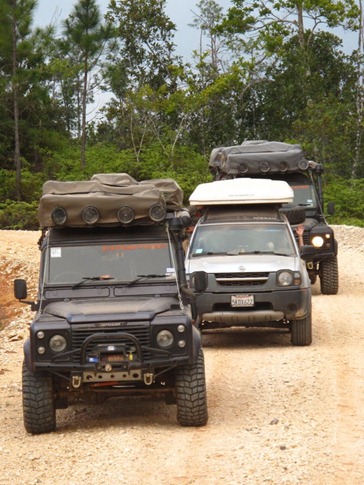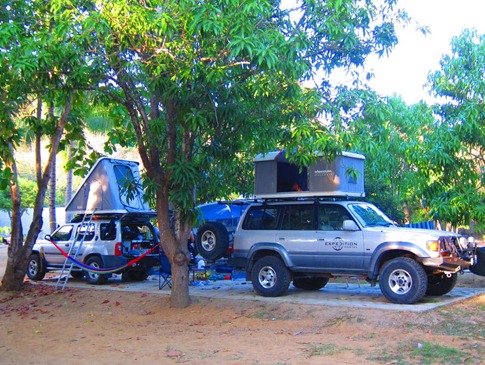A lot of great insights by people who were (or still are!) on the road a lot longer than we were. I had a couple more of our "favorite gear/best ideas" items I thought I'd mention. Not an exhaustive list, just some cool things that worked really well for us...
10L MSR Dromedary Bags
Easier to store and compress than hard sided jugs. Ours just rode like bloated leaches on top of our stuff on the rear deck of the truck. We hang one with the spigot attachment off the roof rack on the side of the truck for a gravity fed water source. Perfect for washing dishes or filling water bottles or brushing teeth. Could leave one on the roof for some warm water. Those “Alhambra” water cooler bottles are available everywhere and 2 10L dromedary bags swallow all 20L up!
DC Flood Light
We found one with a magnetic base that allows it to be mounted over the kitchen area or anywhere on the side of the truck and plugged into the rear cigarette lighter. Came with a 55W bulb which we replaced with a 9W LED bulb (superbrightleds.com) taking the draw from 4 amps to less than 1 which is a lot easier on your battery. Great for cooking or roadside repairs.
"A typical feast on the tailgate kitchen"
Gorillapod Magnetic Flexible Tripod
I thought the original Gorillapod was awesome but after replacing a lost one with a copy that fell apart immediately, I found this one, now with magnetic feet! With a small camera like our Canon s95, it’ll hold on poles, beams, the side of the truck, wherever in addition to being able to use the fingers on railings, trees, etc. Great for low light settings like churches or long exposures like stars or the moon. Also grab a couple extra tripod heads for your video camera or audio recording device to be able to click and go.
"Long exposure above Los Mochis before heading into the Copper Canyon"
Spot Tracker
I don't know if anyone mentioned it but we love having it. Transmits our location which can be displayed on our blog and can be used to send pre-set status messages to family. For $12 extra, we bought additional search and rescue coverage. Check the Spot site for details and info on the latest versions with 2 way messaging etc.
I also had a couple comments on vehicle decisions/prep...
Go low pro
We were really happy to be driving a vehicle that doesn’t get a lot of attention. We typically weren't given a second look by cops or anyone else as we were driving around. It’s already easy to a feel a little “exposed” far away from home in a different country. It doesn’t take much to feel pretty darn flashy down there and sometimes it’s nice to just blend in. That means minimal exterior mods. We had a rear tire carrier and the low pro AutoHome RTT that looks a lot like a storage box. Spend your energy tricking out the interior features like camp kitchen and gear storage.
"One of these kids does not belong here..."
Lock everything down/Make use of unlikely space (note, this is for the more paranoid among us... NOT necessary unless you - like me - need the peace of mind)
See above but that means minimize gear outside the vehicle and also, put things away on the inside. We built a custom "cabinet" in the rear cargo area that held our kitchen with the back hatch open and allowed access to our personal items by folding forward the back seats. It's not really about stopping a thief - they can snip padlocks - it's about not appearing to be a target in the first place and if you are, discouraging opportunists. For really valuable items, we buried them in unlikely places in the truck. Take out a few screws and look for hidden storage. We found a panel underneath the rear seat cushion that provided access to the fuel pump but also served as a well hidden spot for some extra cash and our prescription drugs (that we didn't want to explain at borders). Same with the space left under our kitchen when we relocated the factory jack and tools. We also found a couple ammo boxes and a thin, flat gas tank meant for ATV's that would subtly slide onto the roof between the racks and underneath the RTT. Finally, when we found that the spare wouldn't fit in the factory location with our new tire carrier bumper, we found an ammo box that could be hoisted into place using the chain that held the tire.

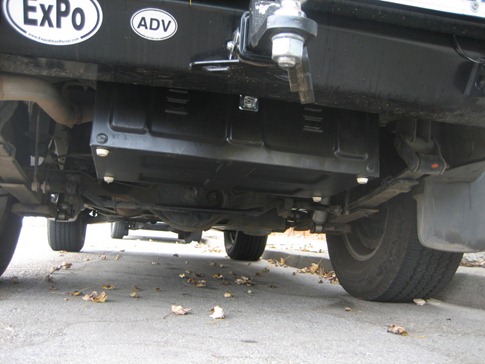
Kill switch
Yup, one final "peace of mind" item that I was really happy to have. While a battery disconnect is an easy way to go, it's pretty easily detected. I went to junkyard and found a factory switch that fit in a blank space in the dash and had a local shop wire it up to the fuel pump. The switch had a picture of the rear windshield wiper on it but, without being turned on, would cause the truck to just try and try and try to turn over but fail. Rest assured, a returned to the truck a couple times after a sunset cerveza and started to panic when it wouldn't start. Then I'd remember my failsafe... Again, overkill? Perhaps. A good measure of assurance your truck will be where you left it? Yep and worth it to us.
(wiper button at far left in the pic is the kill switch)
Yup, lots of different ways to hit the road. I'm sure everyone who's done it to one degree or another would say that the most important this is just to DO IT!
Dave

